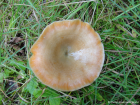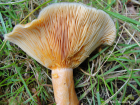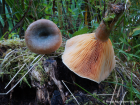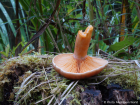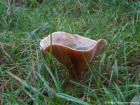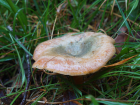Cap first round with a slightly depressed centre and rolled-in margin. Then shallow to funnel-shaped. The colour is yellowish orange zoned with darker areas and nearly always with irregular green patches. It is sticky or slippery when wet. Gills dense and slightly extending downward. Same colour as the cap. Stem similar in colour as the cap, smooth, tough, but at the same time delicate and fragile. The stem has no ring. Flesh dirty gray colored. It turns orange at the edges because of the carrot-coloured milky liquid that escapes when broken. Spore print pale pinkish buff.
Microscopic Features: The spores measure 7-10 x 6.5-7.5 µm and have an ellipsoid shape. They are ornamented with amyloid warts and ridges that extend up to about 0.5 µm in height. Fairly frequent connectors form partially reticulate patterns.
Lactarius deterrimus on the First Nature Web site.
Lactarius deterrimus on the MushroomExpert.Com Web site.
Many mushrooms are poisonous, and some can be lethally toxic. Distinguishing between edible and poisonous mushrooms can be very challenging. Therefore, we strongly advise against consuming wild mushrooms. This website does not contain any information about the edibility or toxicity of mushrooms.
Although efforts have been made to ensure accuracy on this website, the information may contain errors and omissions. Therefore, all content provided is for educational and informational purposes only and should not be relied upon or used as a basis for consuming any plants or mushrooms.
External links are provided for reference only. We do not endorse or take responsibility for the content, advice, or products found on these sites or in any advertisements shown on this website.
